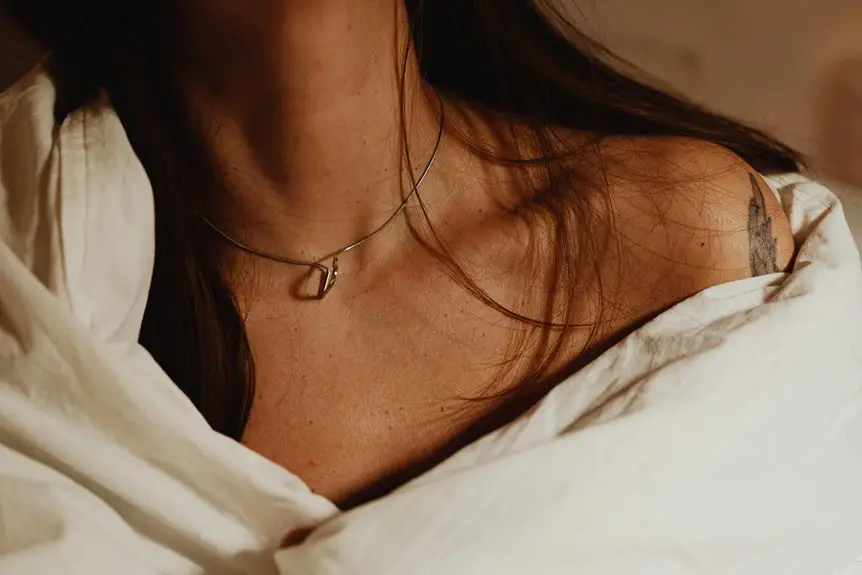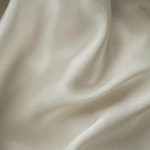When choosing between camel hair and goat hair (mohair), consider their softness, warmth, and durability. Camel hair offers exceptional insulation due to hollow fibers, making it perfect for very cold weather, and has a smooth, luxurious feel. Mohair is lighter with a silky sheen and great crease resistance, ideal for moderate climates and long-lasting use. Both require careful care and come from renewable sources. If you want to explore their unique qualities further, there’s more to discover about these elegant fabrics.
Table of Contents
Key Takeaways
- Camel hair is softer with natural insulation from hollow fibers, making it warmer for extreme cold compared to mohair’s lighter warmth and breathability.
- Mohair fibers are long, lustrous, and more durable, resisting creases and abrasion better than camel hair, which may pill over time.
- Camel hair is pricier and rarer, sourced mainly from wild camels, while mohair is more affordable with established farming from Angora goats.
- Both fibers are renewable, biodegradable, and require dry cleaning and careful storage to maintain quality and prevent damage.
- Camel hair suits luxury outerwear with elegant warmth, whereas mohair is versatile for suits, sweaters, and upholstery with a silky sheen and excellent drape.
Origins and Sources of Camel Hair and Mohair
Although both camel hair and mohair come from animals, they originate from very different species and environments.
You’ll find camel hair comes from the Bactrian camel, native to the cold deserts of Central Asia. This hair is harvested during the shedding season, usually by combing or shearing.
On the other hand, mohair comes from the Angora goat, which thrives in the semi-arid regions of Turkey, South Africa, and the United States. You’ll notice that mohair is collected twice a year by shearing the goats, making it a renewable resource.
Both fibers reflect the unique climates and habitats of their sources, influencing their qualities and uses in fabric production. Understanding these origins helps you appreciate their distinct characteristics.
Physical Characteristics of Camel Hair
When you feel camel hair, you’ll notice its unique softness and smooth texture.
The fibers vary in length and thickness, influencing how the fabric drapes and wears.
Plus, natural color variations give camel hair a warm, earthy appeal you won’t find in many other fabrics.
Texture and Softness
Camel hair offers a unique texture that many find irresistibly soft and warm. When you touch camel hair fabric, you’ll notice its smooth, fine feel, which sets it apart from rougher wools. It’s naturally gentle against your skin, making it ideal for those who dislike itchy fabrics.
You’ll appreciate how the softness comes from the undercoat fibers, which are denser and finer than the outer guard hairs. This combination gives camel hair a plush, cushioned sensation without feeling heavy.
While it’s soft, the fabric also retains enough structure to keep garments looking refined and polished. If you want cozy warmth paired with a luxurious, smooth texture, camel hair is a smart choice that balances comfort and elegance perfectly.
Fiber Length and Thickness
If you want to understand why camel hair feels so soft yet durable, you need to look at its fiber length and thickness.
Camel hair fibers typically range between 3 to 5 inches in length, which is longer than many other natural fibers. This length helps the fibers intertwine more densely, giving the fabric strength and resilience.
At the same time, the fiber diameter is relatively fine, usually around 16 to 20 microns, which contributes to its softness against your skin.
The combination of longer, fine fibers allows camel hair to create a smooth, luxurious fabric that holds up well over time.
When you choose camel hair, you’re getting a textile that balances strength with comfort through these physical characteristics.
Natural Color Variations
Although you might expect camel hair to come only in a single shade, its natural color variations offer a subtle but appealing range.
You’ll find hues from light beige and sandy tan to deeper caramel and rich brown tones. These variations depend on the camel’s breed and environment, giving each fiber a unique character.
When you choose camel hair fabric, you get an earthy, warm palette that doesn’t require dyeing, preserving the fiber’s natural softness and strength.
These natural shades blend easily with many wardrobe colors, making camel hair versatile.
Unlike synthetic fabrics, the gentle color shifts in camel hair add depth and texture to your garments, ensuring your pieces look both elegant and authentic without artificial coloration.
Physical Characteristics of Mohair
Mohair stands out for its unique texture and strength, making it a prized fabric choice. When you touch mohair, you’ll notice its smooth, silky feel—far less prickly than many other wools.
Its fibers are long and lustrous, giving the fabric a natural sheen that catches the light beautifully. You’ll find mohair to be strong yet flexible, resisting creases and wrinkles easily.
Unlike some fibers, mohair holds its shape well, so garments made from it maintain a polished look over time. The fabric’s durability means it can handle frequent wear without losing its soft touch or vibrant appearance.
If you want a fabric that combines elegance with resilience, mohair delivers on both counts with its distinctive physical qualities.
Warmth and Insulation Properties
When choosing between camel hair and goat hair, you’ll want to evaluate how well each fabric retains heat and manages moisture.
You’ll also need to think about breathability to stay comfortable in different temperatures. Understanding these factors helps you pick the right fabric for the season.
Heat Retention Efficiency
Because both camel hair and goat hair come from animals adapted to cold climates, they naturally offer excellent heat retention.
When you wear camel hair, you benefit from its hollow fibers that trap air, creating a natural insulation layer to keep you warm.
Goat hair, especially mohair, also excels at heat retention due to its smooth, resilient fibers that hold warmth effectively without adding bulk.
You’ll find camel hair slightly better at maintaining consistent warmth in extremely cold conditions, while mohair provides warmth with a lighter feel.
Both fabrics excel in heat retention, but your choice may depend on whether you prefer the heavier insulation of camel hair or the lighter, yet still effective, warmth of mohair.
Either way, you’ll stay comfortably warm in chilly weather.
Breathability and Moisture Control
While both camel hair and goat hair keep you warm, how they handle breathability and moisture can affect your comfort throughout the day.
Camel hair naturally wicks moisture away, helping you stay dry and comfortable, especially during physical activity. Goat hair, particularly mohair, is highly breathable and resists moisture buildup, preventing clamminess.
Both fabrics excel at regulating temperature, but their moisture control differs in subtle ways.
- Camel hair absorbs moisture slowly, releasing it gradually.
- Mohair dries faster due to its smooth fiber structure.
- Both fibers allow air circulation, reducing overheating.
- Neither fabric feels sticky when you sweat lightly.
Choosing between them depends on your activity level and preference for moisture management in your clothing.
Seasonal Suitability
Although both camel hair and goat hair offer excellent insulation, their warmth levels and seasonal suitability vary, influencing which fabric you might choose for different weather conditions.
Camel hair is known for its superior warmth, making it ideal for chilly winter months. It traps heat effectively, so you’ll stay cozy without feeling weighed down.
Goat hair, especially mohair, is lighter and more breathable, making it better suited for changing seasons like spring and fall. It provides moderate warmth while allowing air to circulate, preventing overheating.
If you want a versatile fabric for year-round wear, goat hair might be the better choice. But if you need maximum insulation during the coldest months, camel hair is the way to go.
Choose based on your climate and comfort needs.
Durability and Care Requirements
Durability plays an essential role when choosing between camel hair and goat hair fabrics.
You’ll find that camel hair is strong but more prone to pilling and wear over time, especially with frequent use. Goat hair, particularly mohair, is tougher and resists abrasion better, making it last longer under regular wear.
When caring for both fabrics, keep these tips in mind:
- Avoid machine washing; opt for dry cleaning to maintain fiber integrity
- Store in a cool, dry place to prevent moth damage
- Brush gently to remove dirt and restore nap without damaging fibers
- Handle with care to avoid stretching or distorting the material
Common Uses in Fashion and Textiles
Because camel hair offers a soft, warm texture, you’ll often find it used in luxury outerwear like coats and scarves. Its natural insulation makes it perfect for cold climates, and its smooth finish adds a touch of elegance to your wardrobe.
Camel hair’s soft warmth and natural insulation make it ideal for elegant, cozy outerwear in cold weather.
On the other hand, goat hair, particularly mohair, shines in both fashion and textiles due to its lustrous sheen and strength. You’ll see mohair in suits, sweaters, and even upholstery fabrics. It provides a silky feel and excellent drape, making it a favorite for stylish, durable garments.
When choosing between the two, consider camel hair for cozy, classic pieces and mohair for versatile, refined items that hold shape and resist wrinkles.
Both fabrics bring unique qualities to your clothing and textile choices.
Environmental Impact and Sustainability
When you evaluate the environmental impact of camel hair and goat hair, you’ll find both have distinct sustainability profiles.
Camel hair is often sourced from wild or semi-wild camels, which means it requires minimal farming and less environmental disturbance. Goat hair, especially mohair, comes from Angora goats that need active farming, which can impact land use and water resources.
However, both fibers are biodegradable and renewable, making them eco-friendly compared to synthetic fabrics.
To help you decide, here are key points to evaluate:
- Camel hair production generally involves less intensive land and water use.
- Mohair farming requires careful management to prevent overgrazing.
- Both fibers reduce reliance on petroleum-based textiles.
- Ethical sourcing and animal welfare practices vary by producer and affect sustainability.
Choosing responsibly sourced fibers helps you support eco-friendly fashion.
Price and Availability Comparison
Both camel hair and goat hair fabrics come with distinct price points and availability that you should consider before making a purchase.
Camel hair tends to be pricier due to its limited supply and the labor-intensive process of collecting the undercoat. You’ll find camel hair mostly in high-end boutiques or specialty stores, making it less accessible.
On the other hand, goat hair, specifically mohair, is generally more affordable and easier to source. Mohair’s wider production and better-established supply chains mean you can find it in a broader range of retailers.
If budget and availability matter to you, goat hair offers more options, while camel hair remains a luxury choice. Knowing this helps you decide which fabric suits your needs and wallet best.
Frequently Asked Questions
Can Camel Hair or Mohair Cause Allergic Reactions?
You might experience allergic reactions to both camel hair and mohair, especially if you’re sensitive to animal fibers. It’s best to test a small area first, as reactions vary depending on your individual sensitivity.
How Do Camel Hair and Mohair Fabrics Feel Against Sensitive Skin?
Imagine a gentle breeze brushing your skin—camel hair feels soft and warm, like a cozy hug. Mohair, though silky, can sometimes prick sensitive skin. You’ll want to test both before choosing what comforts you best.
Are Camel Hair and Mohair Fabrics Suitable for Summer Clothing?
You shouldn’t choose camel hair for summer since it’s heavy and warm. Mohair, though lightweight and breathable, can be a better option if you want a cooler, soft fabric that still offers some insulation on cooler summer days.
Do Camel Hair and Mohair Fabrics Require Special Storage Conditions?
Wondering how to keep your delicate fabrics fresh? You’ll want to store them in a cool, dry place, away from sunlight and moisture. Don’t forget to use breathable garment bags to prevent damage and maintain softness!
Can Camel Hair and Mohair Be Blended With Other Fibers?
Yes, you can blend camel hair and mohair with other fibers like wool or silk to enhance durability, texture, and appearance. These blends improve fabric strength and comfort while maintaining luxurious softness and warmth.
- Does Chiffon Fabric Stink - July 15, 2025
- Does Chiffon Fabric Affect the Economy - July 15, 2025
- Does Cotton Fabric Have a Nap - July 15, 2025







